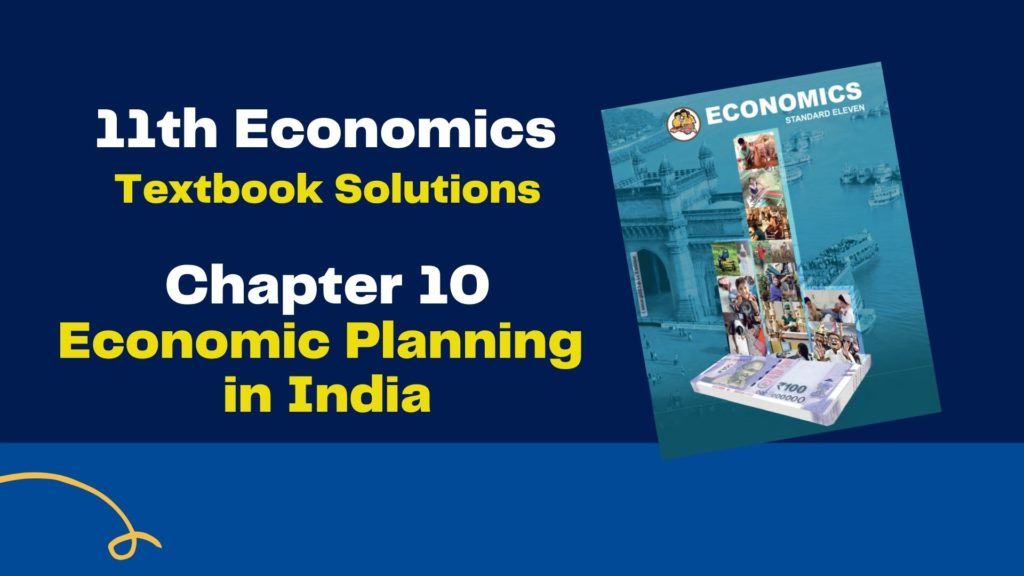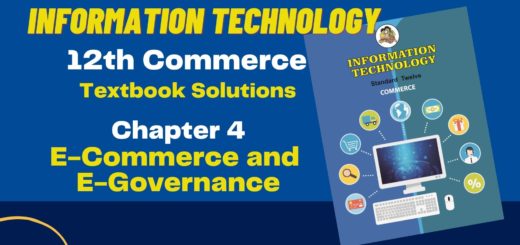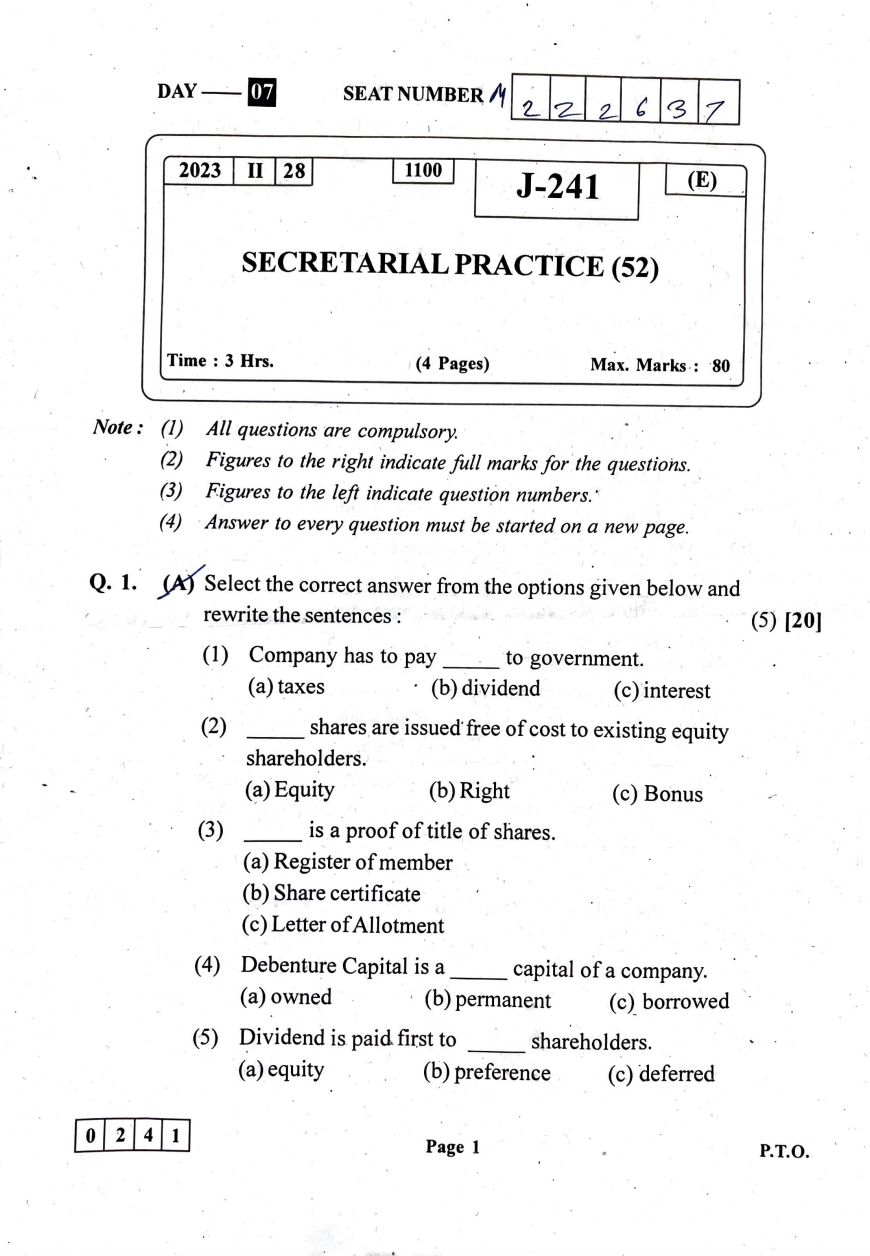11th Economics Chapter 10 Exercise Answer (Economic Planning in India) Maharashtra Board – Free Solution
Table of Contents
11th Economics Chapter 10 Exercise

Chapter 10 – Economic Planning in India
Q. 1. Choose the correct option
1) Statements that are true about the Planning Commission :
a) Planning Commission was established in 1950.
b) The Prime Minister is the Ex-Officio Chairman of Planning Commission.
c) Economic planning is a time-bound programme.
d) Economic planning is based on predetermined objectives.
Options :
1) a and b
2) a, b, c and d
3) a and c
4) None of these
2) Statements that are incorrect regarding India’s five year plans :
a) The main objective of first five-year plan was development of agriculture.
b) Social welfare and poverty eradication were the prime objectives of the seventh five-year plan.
c) By the second five-year plan, focus increased on faster, inclusive growth.
d) Development of both agriculture and industry were the main objectives of the third five year plan.
Options :
1) a
2) a, b and d
3) c
4) b and d
3) Identify the correct pairs from the given options :
| A | B |
| 1) Economic Planning | a) Selection by Prime Minister |
| 2) Twelfth Five Year Plan | b) Think Tank group of Indian Government |
| 3) NITI Aayog | c) Fast and sustainable growth |
| 4) NITI Aayog ice-Chairperson | d) Time-bound program |
Options :
1) 1-c, 2-a, 3-d, 4-b
2) 1-d, 2-b, 3-a, 4-c
3) 1-d, 2-c, 3-b, 4-a
4) 1-b, 2-d, 3-c, 4-a
4) Choose the correct statement :
Statement 1 – NITI Aayog takes note of dynamic change in the Indian economy.
Statement 2 – Considering the economic, social, and technological differences in underdeveloped districts, the body plans to implement various programmes and bring about economic changes.
Options :
a) statement 1 is correct
b) statement 2 is correct
c) statement 2 is the result of statement 1
d) there is no relation between statement 1 and statement 2.
Q. 2. Give economic terms
1) Conscious and deliberate choice of economic priorities by some public authority. – Economic Planning
2) A group of people called forth by the government to discuss various problems and also try to find solutions to them. – Think Tank
Q. 3. Identify and explain the concepts from the given illustrations
1) Sayali’s mother maintains a book of accounts for household purpose and plans the expenditure accordingly.
Concept: Economic planning
Explanation: Economic planning is a time bound programme to achieve certain objectives with the help of available resources by the planning authority.
2) Ramabai gets a subsidy on domestic LPG directly transferred to her bank a/c.
Concept: Service Delivery
Explanation: It is one of the important objective of 12th five year plan. Major subsidies and welfare related
beneficiaries to be shifted to a direct cash transfer by using the Aadhar platform linked with bank accounts.
3) To solve classroom related issues, the teacher forms a group of students. This group discusses the problems and finds solutions to it.
Concept: Think-tank
Explanation: Think-tank is a group of experts who are gathered together by an organisation in order to consider various problems, try and work out ways to solve them.
Solution of other subjects
Solution of all Chapters of Economics
1 – 2– 3 – 4 – 5 – 6 – 7 – 8 – 9 – 10
Q.4. Answer the Following
1) Explain the features of Economic Planning.
Answer: Economic planning has the following features
1) Central Planning Authority
Central Planning Authority in a country undertake economic planning. In India, it was known as Planning Commission. It has been replaced by National Institution for Transforming India i.e. NITI Aayog since 2015.
2) A Survey
A comprehensive survey of the economy is undertaken regarding the availability and utilisation of human and
natural resources.
3) Objectives
Economic planning is based on certain pre-determined objectives which are realistic and flexible.
4) Priorities and targets
Priorities are fixed according to the importance of each sector for accelerating economic development.
Target is the concrete step towards the attainment of objectives.
5) Mobilisation of Resources
The resources needed for planning are mobilised through various sources like taxation, domestic savings, deficit financing, public debt, external assistance etc.
6) Plan Period
Plan period varies as per needs. In countries like India, planning is generally for a period of five years.
7) Evaluation
Periodic assessment such as mid term appraisal is done to incorporate necessary changes in priorities and targets of the plan.
8) Continuous Process
Economic planning is a continuous process. It aims at economic development of the country.
9) Co-ordination
States of the country also undertake economic planning along with the centre. Thus, co-ordination between the centre and states is ensured.
10) Flexibility
Central Planning Authority maintains flexibility in its approach. This makes it possible to incorporate necessary
changes in the plan as per requirements during its implementation.
2) Explain the targets of 12th Five Year plan.
Answer: Following were the targets of 12th five year plan:
1) Economic Growth
• Real GDP growth rate at 8% to be achieved.
• Agriculture growth rate at 4.0% to be gained.
• Manufacturing or Industrial growth rate at 10% to be achieved.
• Every State must have a higher average growth rate in the 12th plan than what was achieved in the 11th plan.
2) Poverty and Employment
• To reduce head-count ratio of poverty by 10%.
• To create 50 million new work opportunities in the non-farm sector.
3) Education
• Mean years of schooling to increase to seven years by the end of the twelfth plan.
• Access to higher education with reference to skill development.
• Eliminate gender and social gap in school enrolment by the end of this plan.
4) Health
• Reduce total fertility rate to 2.1%
• Reduce undernutrition among children in the age group of 0 to 3 years to half of the NFHS-3 levels.
5) Infrastructure
• Investment in infrastructure to be increased to 9% of GDP.
• Connect all villages with all weather roads.
• Increase in rural tele vision and telephone density to 70%
6) Environment and sustainability
• Increase green cover by 1 million hectare every year during the 12th plan period.
7) Service Delivery
• Provide access to banking services to 90% Indian households by the end of the plan.
• Major subsidies and welfare related beneficiaries to be shifted to a direct cash transfer by using the Aadhar platform linked with bank accounts.
3) Explain the structure of NITI Aayog.
Answer: Structure of NITI Aayog:
The Resolution dated 1st January 2015 and its subsequent amendment dated 16 th February 2015, provides for the structure of NITI Aayog as follows :
1) Governing Council
Comprising of the Chief Ministers of all States and Governors of Union Territories.
2) Regional Councils
These would be formed to address specific issues and contingencies impacting more than one state or region.
3) Special Invitees
These would include experts, specialists and practitioners with relevant knowledge who will be nominated by the Prime Minister.
4) Organisational Framework
• Chairperson : Prime Minister of India
• Vice Chairperson : To be appointed by the Prime Minister.
Full time members – 5
Part time members – 2
• Ex-Officio Members : Maximum of 4 members of the Union Council of Ministers to be nominated by the Prime Minister.
• Chief Executive Officer (CEO) : To be appointed by the Prime Minister for a fixed tenure, in the rank of Secretary to the Government of India.
• Secretariat– As deemed necessary.
4) Explain the functions of NITI Ayog.
Answer: Functions of NITI Aayog:
1) Shared National Agenda
Evolves a shared vision of national development priorities and strategies with the active involvement of states. This will provide a framework of ‘National Agenda’ for the Prime Minister and Chief Ministers to implement.
2) States’ Best Friend at the Centre
Supports states in addressing their own challenges, building on strengths and comparative advantages. This will be through various means such as co-ordinating with Ministries, championing their ideas at the centre, providing consultancy support and building capacity.
3) Decentralized Planning
Restructuring the planning process into bottom-up model, from village-level i.e. local government to national level or central government.
4) Knowledge and Innovation Hub
Be an accumulator as well as booster of research and best practices on good governance, through a State-of-the-art Resource centre which identifies, analyses, shares and facilitates replication of the same.
5) Monitoring and Evaluation
Monitor the implementation of policies and programmes and evaluate their impact through rigorous tracking of performance metrics and comprehensive programme evaluations. This will identfy weaknesses and bottlenecks for necessary course correction, enable date- driven policy making, encouraging greater efficiency and effectiveness.
6) Co-operative and Competitive Federalism
Be the primary platform for operationalizing co-operative federalism, enabling states to have active participation in the formulation of national policy and achieving time-bound implementation of quantitative and qualitative targets through the combined authority of the Prime Minister and Chief Ministers of the states.
7) Others Functions
• Inter consultancy
• Conflict Resolution
• Technological upgradation
5) Distinguish between Planning Commission and NITI Aayog.
Answer:
| Planning Commission | NITI Aayog |
| 1) Planning Commission was established on 15th March 1950. | 1) NITI Aayog was established on 1st January 2015. |
| 2) Planning Commission enjoyed the powers to allocate funds to Ministry and State governments. | 2) NITI Aayog is an advisory body or a think tank that performs the function of allocation of funds. |
| 3) Role of states was restricted to the National Development Council (NDC) and annual interaction during Plan meetings. | 3) State governments are expected to play a more significant role. |
| 4) Secretaries or member secretaries were appointed through the usual process. | 4) Secretary known as CEO, to be appointed by the Prime Minister. |
| 5) Planning Commission had no provision for part-time members. | 5) NITI Aayog has a number of part time members, depending on the need from time to time. |
| 6) Planning Commission had a Chairperson, a Member Secretary and full time members. | 6) NITI Aayog comprises of Chairperson, Vice-Chairperson, Full time members, Part-time members, Ex-officio members and CEO of Secretary Rank. |
| 7) Planning Commission framed policies for States and tied allocation of funds with approval of the project. | 7) NITI Aayog is only a think tank and does not have the powers to frame policies. |
Solution of other subjects
Solution of all Chapters of Economics
1 – 2– 3 – 4 – 5 – 6 – 7 – 8 – 9 – 10
Q.5. State with reasons whether you agree or disagree with the following statements
1) State governments have a more significant role to play under NITI Aayog.
Answer: Yes, I agree with this statement.
Reasons: a) NITI Aayog assumes the active role of states in implementing plans. NITI Aayog provides a framework for the national agenda for the PM and CM for implementation.
b) NITI Aayog Supports states in addressing their challenges, building on strengths and comparative
advantages.
c) This will be through various means such as co-ordinating with Ministries, championing their ideas at the
centre, providing consultancy support and building capacity.
d) Thus, State governments have a more significant role to play under NITI Aayog.
2) Functions of Planning Commission has been transferred to NITI Ayog.
Answer: Yes, I agree with this statement.
Reasons: a) Central Planning Authority in a country undertakes economic planning. In India, it was known as Planning Commission.
b) Planning Commission has been replaced by National Institution for Transforming India i.e. NITI Aayog since 2015.
c) Resolution of NITI Aayog was sanctioned on 1st January 2015, but its actual execution started after completing the 12th five-year plan.
d) Thus, Functions of Planning Commission has been transferred to NITI Ayog.
3) The objective of the 12th five-year plan was to achieve faster, sustainable and inclusive growth.
Answer: Yes, I agree with this statement.
Reasons: a) Real GDP growth rate at 8% to be achieved, agriculture growth rate at 4.0% to be gained and, manufacturing or Industrial growth rate at 10% to be achieved.
b) To reduce head-count ratio of poverty by 10%. To create 50 million new work opportunities in the non-farm sector.
c) It also had the target of spreading education and health facilities, developing infrastructure, sustaining the environment, etc.
d) Thus, the objective of the 12th five-year plan was to achieve faster, sustainable and inclusive growth.
Q.7. Read the following passage carefully and answer the questions.
The Finance Minister of the Central Government presents the Union Budget before the Parliament during the month of February every year. The budget, also referred to as the annual financial statement reflects the estimated receipts and expenditures of the government for a particular financial year that begins on the 1st of April and ends on 31st March. Changes in the tax structure are suggested in the budget. Besides this, provisions are also made for allocating expenditure on defence, education, research and development etc. The date for presenting the budget has been shifted to the 1st of February every year. This enables generation of funds well in advance prior to the commencement of the financial year.
1) Where is the Union Budget usually presented?
Answer: The Union Budget is presented in the parliament.
2) What all aspects are considered while preparing the budget?
Answer: Changes in the tax structure, provisions for allocating expenditure on defence, education, research and development etc.
3) Why is the date for presenting the budget shifted to the 1st of February?
Answer: The date for presenting the budget has been shifted to the 1st of February. This enables the generation of funds well in advance prior to the commencement of the financial year.
4) Explain the term ‘budget’.
Answer: The budget is the annual financial statement that reflects the estimated receipts and expenditures of the government for a particular financial year.
Solution of all Chapters of Economics
| Chapter Name | Solution Link |
| 1) Basic Concepts in Economics | Solution |
| 2) Money | Solution |
| 3) Partition Values | Solution |
| 4) The Economy of Maharashtra | Solution |
| 5) Rural Development in India | Solution |
| 6) Population in India | Solution |
| 7) Unemployment in India | Solution |
| 8) Poverty in India | Solution |
| 9) Economic Policy of India Since 1991 | Solution |
| 10) Economic Planning in India | Solution |
Check out other posts related to the 11th Commerce
| Textbook Solutions of 11th Commerce (All Subjects) | Click Here |
| Free pdf of 11th Commerce Textbooks | Click Here |


![12th Economics Paper Pattern Maharashtra Board (2025-26) [Download Free PDF] 5 Class 12 Paper Pattern Economics](https://scholarsclasses.com/blog/wp-content/uploads/2020/08/Economics-PAPER-PATTERN.png)